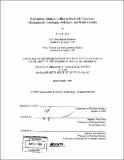| dc.contributor.advisor | Stephen Van Evera. | en_US |
| dc.contributor.author | Welt, Cory | en_US |
| dc.contributor.other | Massachusetts Institute of Technology. Dept. of Political Science. | en_US |
| dc.date.accessioned | 2005-09-27T18:11:02Z | |
| dc.date.available | 2005-09-27T18:11:02Z | |
| dc.date.copyright | 2004 | en_US |
| dc.date.issued | 2004 | en_US |
| dc.identifier.uri | http://hdl.handle.net/1721.1/28757 | |
| dc.description | Thesis (Ph. D.)--Massachusetts Institute of Technology, Dept. of Political Science, 2004. | en_US |
| dc.description | Includes bibliographical references (p. 305-320). | en_US |
| dc.description.abstract | (cont.) the USSR and finds that a focus on opportunity provides the best explanation for the presence or absence of mass mobilization. Finally, the dissertation argues that conventional state security concerns best explain the start of escalation. Union republic opponents, Azerbaijanis and Georgians, perceived regional mobilization to be manifestations of broader "interstate" conflicts pitting Azerbaijan and Georgia against, respectively, Armenia and Russia. They did not consider the actions of regional groups to be a product of group insecurities. The dissertation concludes by applying the above findings to the practice of conflict resolution. | en_US |
| dc.description.abstract | This dissertation investigates the origins of ethnic conflict in the South Caucasus. It explains the mass mobilization of regional groups in Mountainous (Nagorno) Karabagh, Abkhazia, and South Ossetia from 1987 to 1989, variation in the goals of these groups (and of other regional groups in the USSR), and the start of the conflict-spirals that ultimately led to ethnic war. The dissertation examines three aspects of mass mobilization: group motivation, the commitment problem, and perceptions of opportunity. Utilizing historical memories, leadership rhetoric, signals of opponent intentions, and evidence of shifting capabilities, the dissertation assesses four hypotheses for group motivation: fear of violence, cultural extinction, demographic shift, and economic discrimination. It concludes that all three groups were mainly motivated by a fear of future demographic shifts and economic discrimination. The dissertation argues that the three regional groups also shared a political commitment problem--the absence of a mechanism that guaranteed union republic opponents would protect their demographic and economic interests after they agreed to a compromise. Contemporary signals of intent and historical precedents led groups to believe their opponents were committed to state centralization, not the expansion of regional autonomy. Regarding opportunity, two regional groups believed their demands coincided with Mikhail Gorbachev's commitment to rectify "deviations" from the early Soviet path of state development and could thus persuade the central government to accommodate their demands. The third regional group did not and so pursued a more modest political goal. The dissertation applies the above findings to cases of regional mobilization (and its absence) elsewhere in | en_US |
| dc.description.statementofresponsibility | by Cory D. Welt. | en_US |
| dc.format.extent | 320 p. | en_US |
| dc.format.extent | 19605622 bytes | |
| dc.format.extent | 19649253 bytes | |
| dc.format.mimetype | application/pdf | |
| dc.format.mimetype | application/pdf | |
| dc.language.iso | en_US | |
| dc.publisher | Massachusetts Institute of Technology | en_US |
| dc.rights | M.I.T. theses are protected by copyright. They may be viewed from this source for any purpose, but reproduction or distribution in any format is prohibited without written permission. See provided URL for inquiries about permission. | en_US |
| dc.rights.uri | http://dspace.mit.edu/handle/1721.1/7582 | |
| dc.subject | Political Science. | en_US |
| dc.title | Explaining ethnic conflict in the South Caucasus : Mountainous Karabagh, Abkhazia, and South Ossetia | en_US |
| dc.type | Thesis | en_US |
| dc.description.degree | Ph.D. | en_US |
| dc.contributor.department | Massachusetts Institute of Technology. Department of Political Science | |
| dc.identifier.oclc | 59823134 | en_US |
